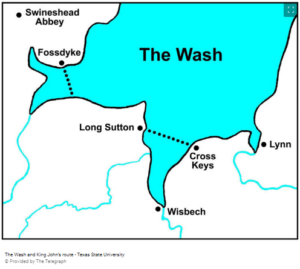The Wash is a large rectangular indentation in the eastern coast of England, where Norfolk meets Lincolnshire. The name Wash may have been derived from Old English
wāse meaning mud, slime or ooze. Several rivers empty into the Wash, and travelling around it is a long way. When the tide is low it is possible to shorten the journey by crossing the sands.
In October 1216 King John was travelling from Spalding, Lincolnshire, to Bishop’s Lynn, Norfolk, but was taken ill and decided to return. While he took the longer route around the Wash by way of Wisbech, he sent his baggage train, comprising horse-drawn wagons, along the causeway and ford across the mouth of the Wellstream, a route usable only at low tide, to arrive ahead of him.
The tide came in very high and the baggage train was too slow to beat the tide and was washed away. The baggage included the crown jewels. Their loss was a major disaster, which John didn’t have to deal with, as he died, probably of food poisoning, a few days later. He was recorded as staying the following night, 12–13 October 1216, at Swineshead Abbey, moving on to Newark-on-Trent, and dying of his illness on 19 October.
So that’s the history, what about the science? There has always been some doubt about why the baggage train attempted to cross the Wash, when the tides would have been known by local people.
The Telegraph newspaper reports that Prof Donald Olson, an astronomer from Texas State University, discovered that the king’s misfortune was not because of poor planning or route choice, but a freakishly large wave called a “tidal bore”.
When the sun and the moon line up with the earth their effect on tides is cumulative. Not only were they aligned on that fateful day, but it was at the time of the moon’s closest approach to the earth. The moon’s orbit of the earth isn’t circular but elliptical, so the distance between the two varies. The nearer the moon, the higher the tides.
By tracing the position of the moon and sun back in time in relation to the earth the astronomer calculated this conjunction on the day King John’s baggage train was crossing the Wash. This two-in-one combination of astronomical forces is known as a perigean spring tide, which leads to enlarged tides for a matter of days, and occurs just twice every 13 months.
“The astronomical and hydrographical calculations show that the tidal bore would have arrived near 4pm on Oct 12 1216,” Prof Olson told The Telegraph.
 Ann Marie Thomas is the author of five medieval history books, a surprisingly cheerful poetry collection about her 2010 stroke, and the science fiction series Flight of the Kestrel, Intruders, Alien Secrets & Crisis of Conscience are out now Follow her at http://eepurl.com/bbOsyz
Ann Marie Thomas is the author of five medieval history books, a surprisingly cheerful poetry collection about her 2010 stroke, and the science fiction series Flight of the Kestrel, Intruders, Alien Secrets & Crisis of Conscience are out now Follow her at http://eepurl.com/bbOsyz




 Ann Marie Thomas is the author of five medieval history books, a surprisingly cheerful poetry collection about her 2010 stroke, and the science fiction series Flight of the Kestrel, Intruders, Alien Secrets & Crisis of Conscience are out now Follow her at http://eepurl.com/bbOsyz
Ann Marie Thomas is the author of five medieval history books, a surprisingly cheerful poetry collection about her 2010 stroke, and the science fiction series Flight of the Kestrel, Intruders, Alien Secrets & Crisis of Conscience are out now Follow her at http://eepurl.com/bbOsyz